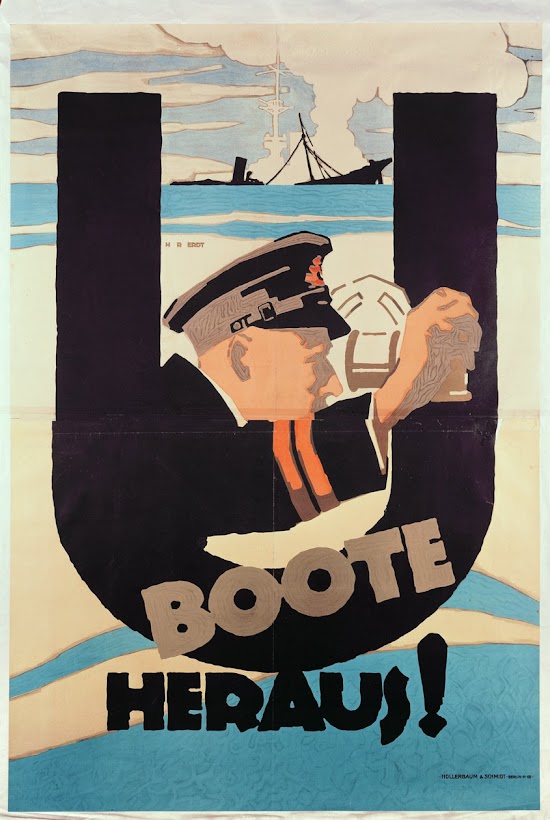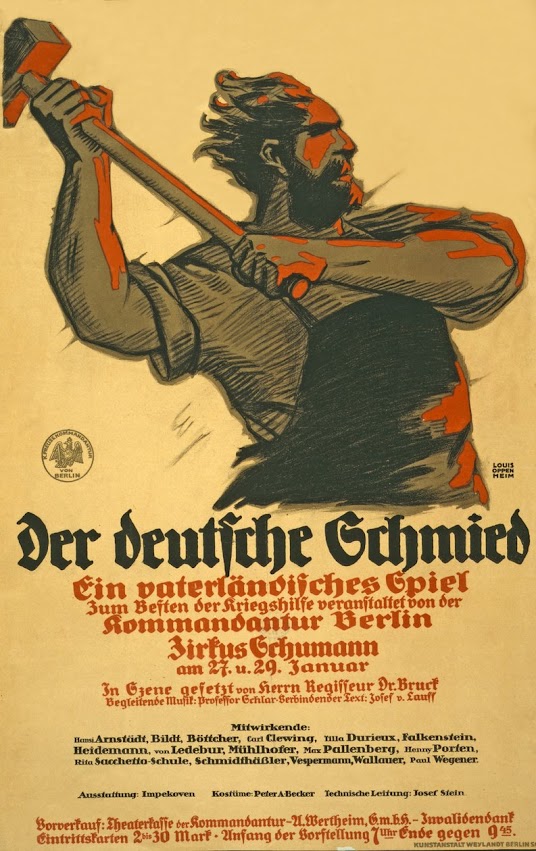During World War 1 the impact of the poster as a means of communication was greater than at any other time during history. The ability of poster to inspire, inform, and persuade combined with vibrant design trends in many of the participating countries to produce thousands of interesting visual works. As a valuable historical research resource, the posters provide multiple points of view for understanding this global conflict. As artistic works, the posters range in style form graphically vibrant works by well-known designers to anonymous ones.
Library of Congress, Washington, D.C.
This is Part 8 of a 10-part series on WW1 posters:
 |
| c1917-18 Service "Fall In" National League For Womans Service artist unknown |
 |
| 1917-18 Do Your Bit! Save Food (artist unknown UK) |
 |
| 1917- 18 Fight with National War Bonds (artist unknown UK) |
Alonzo Earl Foringer was born in Kaylor, Pennsylvania, Foringer spent the early part of his life in Armstrong County. He received artistic training from Horatio S. Stevenson in Pittsburgh, then from Henry Siddons Mowbray and Edwin Howland Blashfield in New York City. Later, he moved to Saddle River, New Jersey. A perpetual bachelor, Foringer's household included his brother, T. Milton, and his sisters, Lilian, Ire, and Edith. The Foringer name was important in local politics between Alonzo's art career and Milton's 31-year career on the Saddle River borough council. |
 |
| 1917 Answer the Christmas Roll Call Join the Red Cross artist Alonzo Earl Foringer |
.jpg) |
| 1918 The Greatest Mother in the World artist Alonzo Earl Foringer (USA) |
.jpg) |
| c1917 Fight World Famine enrol in The Boys Working Reserve (artist unknown USA) |
.jpg) |
| c1917 Join! The American Red Cross artist unknown (USA) |
Henry Patrick Raleigh was an etcher, illustrator, lithographer, and painter. Born in Portland, Oregon, he went on to study at the Hopkins Art Institute in San Francisco, CA. He moved to New York City to become an illustrator for the Saturday Evening PostRaleigh ended up starting and ending his life in poverty and despair. But in between, he spent decades painting high society pictures and living the opulent life of one of the best paid illustrators in the country.
 |
| 1917-18 Hun or Home? Buy More Liberty Bonds artist Henry Patrick Raleigh (USA) |
 |
| c1917 Hunger artist Henry Patrick Raleigh (USA) |
 |
| c1917 My Daddy Bought Me a Government Bond of the Third Liberty Loan Did Yours? artist Henry Patrick Raleigh (USA) |
 |
| 1918 Halt the Hun! Third Liberty Loan artist Henry Patrick Raleigh (USA) |
 |
| 1918 Must Children Die and Mothers Plead in Vain? Buy more Liberty Bonds artist Henry Patrick Raleigh (USA) |
 |
| 1918 Blood or Bread artist Henry Patrick Raleigh (USA) |
 |
| Jonas Lie (USA) |
 |
| c1917 On The Job For Victory artist Jonas Lie (USA) |
Harrison Fisher (1875/77-1934 USA) was born in Brooklyn, New York City and began to draw at an early age. Both his father and his grandfather were artists. Fisher spent much of his youth in San Francisco, and studied at the San Francisco Art Association. In 1898, he moved back to New York and began his career as a newspaper and magazine illustrator, working for the San Francisco Call and the San Francisco Examiner, drawing sketches and decorative work. He became known particularly for his drawings of women, which won him acclaim as the successor to Charles Dana Gibson.
 |
| 1918 "I summon you to Comradeship in the Red Cross" artist Harrison Fisher (USA) |
 |
| Have you answered the Red Cross Christmas Roll Call? artist Harrison Fisher (USA) |
%20For%20Home%20and%20Country%20artist%20Alfred%20Everitt%20Orr%20(1888-%3FUSA).jpg) |
| 1918 (published 1819) For Home and Country artist Alfred Everitt Orr (1888-? USA) |
 |
| Clyde Forsythe (1885-1962 USA) |
.jpg) |
| 1918 And they thought we couldn’t fight artist Clyde Forsythe (USA) |
.jpg) |
| 1918 Ausstellung von Plakaten für die Achte Kriegsanleihe (Exhibition of Posters for the Eighth War Loan) artist G. Haale (Germany) |
.jpg) |
| Siegt der Feinde Hass und Heer... (If the Enemy's Hate and Army Win...) artist G. Haale (Germany) |
Louis Abel-Truchet was a student of Jean-Joseph Benjamin-Constant and Jules Lefebvre at the Académie Julian. His first exhibition came in 1891. He was one of the first exhibitors at the Salon d’Automne in 1903. He and Louis Vallet created the "Société des humoristes" in 1907.
In 1910, he became a member of the Société National des Beaux-Arts. The following year, he was named a Knight in the Legion of Honour.
 |
 |
| before 1918 Comité de l’or Amiens artist Louis Abel-Truchet (France) |
.jpg) |
| L'Araignée du Kaiser (the Kaiser's Spider) artist Louis Abel-Truchet (France) |
Walter Whitehead (1874-1956) was born in Chicago, Illinois, in 1874. He studied at the Art Institute of Chicago before joining the Howard Pyle School of Art about 1901. While at Pyle's school, Whitehead helped Pyle by managing the art supplies which Pyle sold to his pupils at cost.
.jpg) |
| 1918 Come on! Buy more Liberty Bonds artist Walter Whitehead (USA) |
 |
| 1918 Stand by the Boys in the Trenches Mine More Coal artist Walter Whitehead (USA) |
 |
| 1918 See Real Warfare "Over There" Cantonment artist Lloyd Harrison (USA) |
 |
| 1918 Corn The Food of the Nation artist Lloyd Harrison (USA) |
René Lelong (1871-1938) was born in Arrou, France. He was considered one of the finest illustrators in France during the early 20th-century. His work covered an array of subjects but he’s predominantly known for social scenes involving women and striking posters. He was awarded a medal at the Salon of French Artists in 1895, and elected a member of the Salon of French Artists in 1898.
 |
| 1918 3e Emprunt de la Défense Nationale artist René Lelong (France) |
 |
| 1918 Crédit National Pour Faciliter la Réparation des Dommages Causés Par la Guerre artist René Lelong (France) |
%20artist%20B.%20Chavannaz.jpg) |
| 1918 Don National Suisse artist Jules Courvoisier (Switzerland) |
 |
1918 Don National Suisse artist Jules Courvoisier (Switzerland) |
 |
| 1919 A l'Emporte-Pièce Revue des Artilleurs Genevois artist Jules Courvoisier |
 |
| 1918 Emprunt National 1918 artist B. Chavannaz (France) |
 |
| 1918 Emprunt National 1918 artist B. Chavannaz (France) |
 |
| 1918 Emprunt National 1918 artist B. Chavannaz (France) |
%20artist%20B.%20Chavannaz.jpg) |
| 1918 Emprunt de la Libération. (Liberation Loan) artist B. Chavannaz (France) |
.jpg) |
| Ah! Quand supplimeza-t-on l'alccol? (Ah! When was alcohol taken?) artist B. Chavannaz (France) |
 |
| Ah! Si l'on avait suppzine l'alcool (Ah! If we had stopped drinking alcohol) artist B. Chavannaz (France) |
 |
| Emprint de la Paix Crédit Lyonnais artist B. Chavannaz (France) |
.jpg) |
| Pour Forger Une France Puissante (To Forge A Powerful France) artist B. Chavannaz (France) |
.webp) |
| Union des Colonies Éstrangéres (Union of Foreign Colonies) artist B. Chavannaz (France) |
;jpg.jpg) |
| Vous Aussi Faites Votre Devoir (You Too Do Your Duty) artist B. Chavannaz (France) |




%20artist%20Georges%20Scott.jpg)
.jpg)

.jpg)
jpg.jpg)
.jpg)
%20artist%20Achille%20Mauzan%20(1883-1952%20Italy)*.jpg)






































